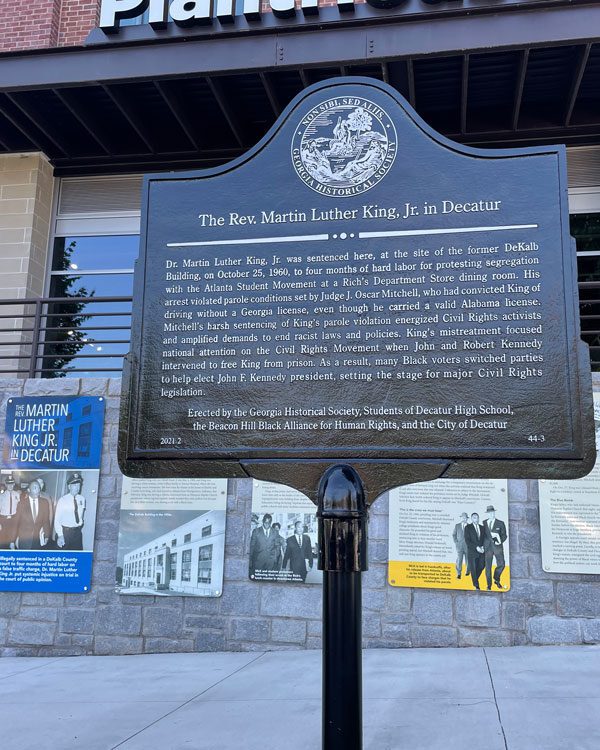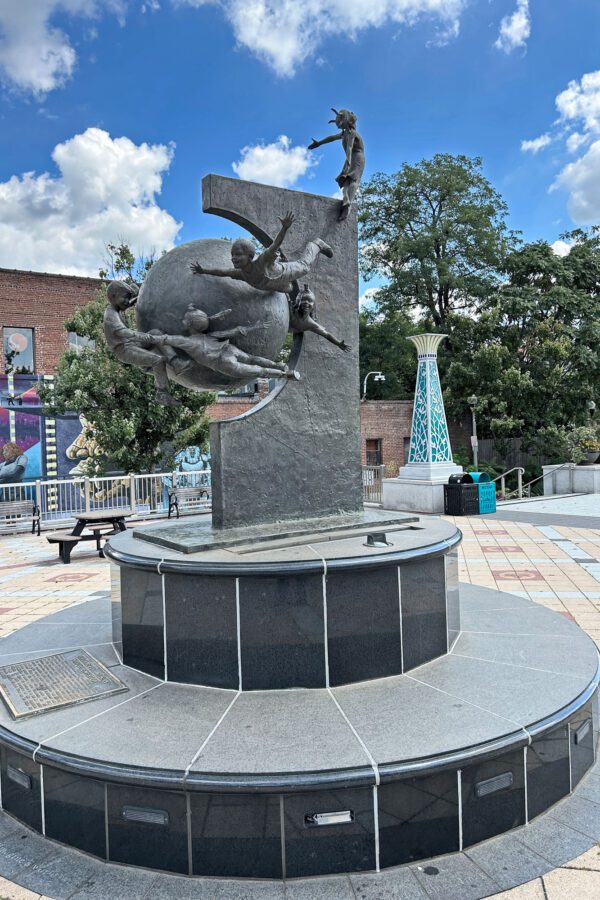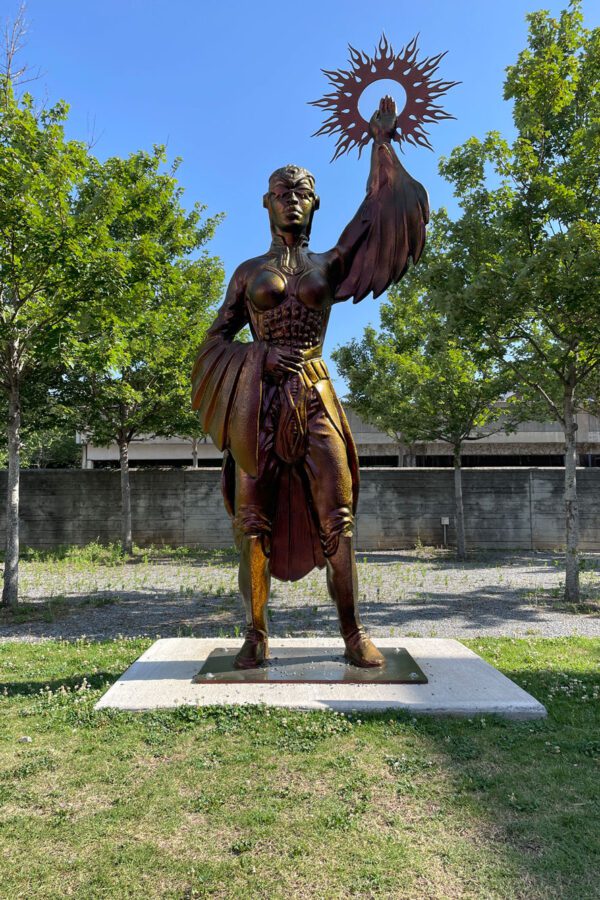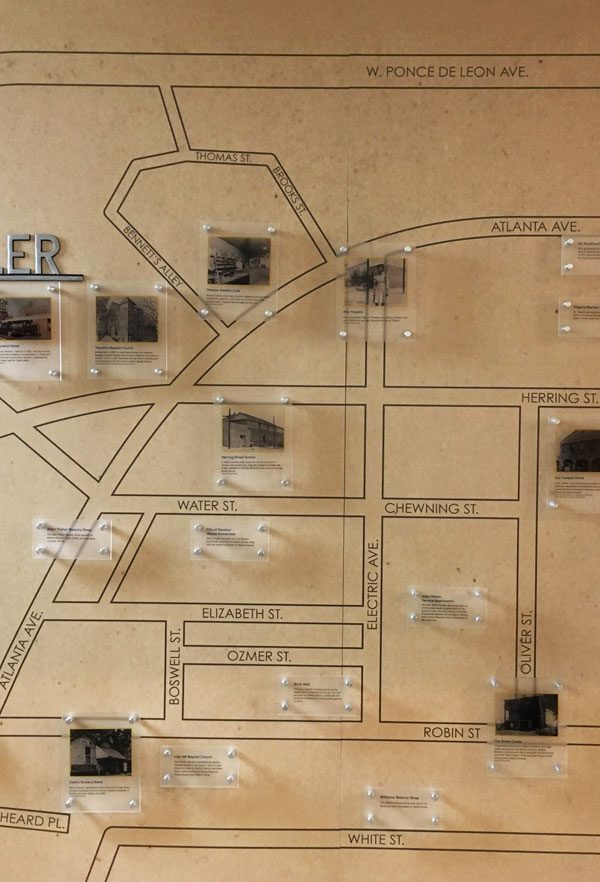From deep roots in Decatur’s earliest days to the brave, unsung acts of our local Civil Rights leaders, we’re committed to sharing the whole narrative of Black history. This self-guided walking tour includes 12 important stops around Decatur including the Beacon Hill Exhibit commemorating Decatur’s historic Black community, and the historical marker and timeline highlighting Martin Luther King Jr.’s time here.
Read more about each walking stop below and use the Google Map to navigate between stops.
The tour was developed in partnership with the Beacon Hill Black Alliance for Human Rights as part of the annual Pan African Festival in downtown Decatur.
Walking Tour Stops
1. “Celebration” by Gary Price
Downtown Decatur Square, On the MARTA Plaza
Commemorates Mayor Emerita Elizabeth Wilson’s leadership in Decatur. Wilson, a long-time Decatur resident, raised her children in the Beacon Community and worked ceaselessly to integrate city schools. In the early 1960s she integrated the Decatur public library. She was the city’s first African-American commissioner and served as mayor from 1993 to 1998.
2. Contextual marker at the site of the “lost cause” monument to the Confederacy
Downtown Decatur Square, Behind the DeKalb History Center / Historic DeKalb Courthouse, 101 E Court Square
In 1908, a monument was erected in Decatur to glorify the “lost cause” of the confederacy. The large obelisk bolstered white supremacy and a false history by suggesting that the cause of the Civil War rested on states’ rights instead of African-American enslavement. Until 2020, state law prevented the monument’s removal until activism by Beacon Hill Black Alliance for Human Rights and Decatur High School students encouraged Superior Court Justice Clarence Seeliger to order its removal.
3. Future site of the John Lewis tribute memorial
Downtown Decatur Square, Behind the DeKalb History Center / Historic DeKalb Courthouse, 101 E Court Square
The former site of a monument to the confederacy will soon be the home of a memorial dedicated to Congressman John Lewis, who died in 2020. He was first elected to represent Georgia’s 5th District (including Atlanta and a portion of Decatur) in the U.S. House of representatives in 1987. In his youth, he served as one of Martin Luther King Jr.’s lieutenants, leading nonviolent protests across the southeast, including the historic march across the Edmund Pettus Bridge in Selma, Alabama.
4. “Lynching in DeKalb County” (historical marker)
DeKalb County Courthouse, 556 N. McDonough St.
Too often the history of lynching in the United States is ignored in favor of a story of continual racial progress. This plaque installed by the NAACP DeKalb Remembrance Project seeks to acknowledge the history of racial terror in DeKalb County from 1877 to 1950 by publicly documenting the lynchings of four Black men between 1877 and 1950. The plaque is one of several markers throughout the county that the DeKalb Remembrance Project has erected to help communities confront their histories of racial violence and begin the process of recovery.
5. “Dr. Martin Luther King Jr. in Decatur” (historical marker)
Southeast corner of N. McDonough Street and W. Trinity Place, 120 W. Trinity Pl.
This historical marker identifies the former site of DeKalb County’s Civil and Criminal Court and Jail. Here, in October 1960 the Rev. Dr. Martin Luther King Jr. was sentenced, jailed, and driven off in chains to Reidsville State Prison to serve a sentence of four months of hard labor for violating probation in a misdemeanor traffic case.
6. Black Lives Matter street painting
In front of Decatur High School, 310 N. McDonough St.
In August 2020, hundreds of community volunteers, organizers, and artists showed up in Downtown Decatur to create this street painting along North McDonough Street proclaiming “Black Lives Matter.” It was designed by three Black artists — Sharanda Wilburn, Petie Parker, and George F. Baker II.
7. “The Bottom,” historic Black community
Allen Wilson Terrace Apartments, 1450 Commerce Dr.
Known as “The Bottom” when it was settled by freed enslaved Africans and African Americans after the Civil War, this square mile of Decatur was the site of a thriving community. “Vanished Community: Decatur’s Beacon Hill 1900-1960,” an oral history project undertaken by former Beacon residents and City of Decatur, identifies Beacon as the heart of Decatur’s African-American community until it was demolished by urban renewal programs in the mid-1960s. The tight-knit area included neighborhoods, schools, churches and a thriving business community that included the L.C. Rib Shack, Tom Steele Café, Spate’s Rib Shack, Roger’s Taxi, Cooper Funeral Home, Starr and Fischer Beauty Shop, Kilgore Barbershop, The Ritz Carver Theater, and Lena’s Beauty Shop.
8. Beacon Community Churches
Robin Street
The Beacon community’s spiritual needs were met by at least eight churches, all within about four blocks of each other. These served as the backbone of the community, and included Antioch African Methodist Episcopal Church, Apostolic Holiness Church, Faith Tabernacle Baptist Church, Lilly Hill Baptist Church, Mount Zion Baptist Church, Thirkield Methodist Church, Trinity Presbyterian Church, and Thankful Baptist Church.The oldest African-American congregation inDecatur, Antioch AME Church, was founded by freed enslaved Africans and African-Americans in 1868. Trinity Presbyterian Church (pictured above) was constructed in 1945 and served families relocated to the Allen Wilson Terrace apartments.
9. Ebster Park
404 W. Trinity Pl.
In 1947 Decatur named this park after Donald Grant Ebster (1874-1965), who was a charter member of the DeKalb County NAACP. Ebster was a prominent Black resident active in civic affairs and his church community. He served asDeacon of the Thankful Baptist Church for more than 40 years. He worked for many years for a local paper company, as a laborer and, later, a porter. Ebster is one of only a few Blacks whose names were inscribed in Decatur’s 20th century landscape. Before officially naming the park after Ebster, the space was identified as a segregated park for Black people.
10. Elizabeth Wilson School Support Center at Beacon Municipal Center
420 W. Trinity Pl.
Like many cities in the south, the school system is at the heart of campaigns to segregate (and to eventually desegregate) communities. Elizabeth Wilson is one of Decatur’s heroes in the battle for educational justice and equality. She played a key role in desegregating Decatur public schools and libraries during the 1960s. A relentless nonviolent protester, Elizabeth Wilson worked tirelessly to dismantle barriers that blocked Black youth from educational achievements. Ms. Wilson later became the city’s first woman and, to date, only African-American mayor (1993 to 1998).
11. Beacon Community: Beacon Municipal Center
420 W. Trinity Pl.
Decatur is taking steps to preserve the history of the Beacon community. That includes the history of Beacon Elementary School and Trinity High School. Although the Supreme Court ruled in 1954 that segregated schools were unconstitutional, it would be 18 years before Decatur’s public schools were completely integrated. In early 2013, three years after receiving a $10,000 historic preservation grant, the City of Decatur began building a new police headquarters and civic plaza, preserving parts of the old Beacon Elementary School and Trinity High School. The Beacon Community historic exhibit at the Ebster Recreation Center was largely produced through the work of Mayor Emerita Elizabeth Wilson.
12. “What Sonia Said” by Ellex Swavoni
420 W. Trinity Pl.
“What Sonia Said” by sculptor Ellex Swavoni is a tribute to the strength, heroism, and resilience of Black communities, especially the Black women who form the backbone of those communities.
Swavoni is the first artist to be commissioned by Art for the People, a project of the Beacon Hill Black Alliance for Human Rights, Decatur
Makers, and the City of Decatur.
Art for the People commissioned “What Sonia Said” to challenge the narrative of structural racism. The project aims to reflect the voices of people of color, advocate for social justice and equity, and lift up themes of racial reckoning, resistance, survival, healing, affirmation, and radical imagination.
Learn more about the Beacon Community at decaturga.com.



